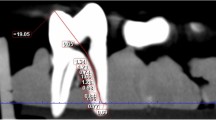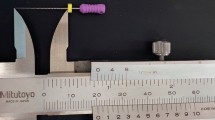Abstract
Objectives
The aim of this study was to evaluate the accuracy of two-dimensional (2D) and three-dimensional (3D) root canal length measurements in molar teeth using cone beam computed tomography (CBCT).
Materials and methods
Root canal lengths of twenty molar teeth were measured with two different CBCT approaches. After adjusting the CBCT images, 2D measurements were performed within the sagittal plane between the apical foramen and the coronal reference (cusp). The 3D approach measured centrically in axial planes. A linear mixed model with random intercepts was fitted to compare differences between methods (2D and 3D). The correlation between CBCT measurements and the actual root canal length was evaluated using the Pearson correlation coefficient.
Results
Differences between 3D measurements and the actual root canal lengths were significantly smaller compared to the 2D approach (p < 0.001). Mean differences were 0.32 and 0.58 mm, respectively. A high correlation was found between the actual root canal length and 3D measurements (Pearson correlation coefficient = 0.97). Compared to the actual root canal length, 80 % of the 3D measurements were within the limits of ±0.5 mm.
Conclusions
3D measurements of root canals in molar teeth are more accurate than simple 2D measurements and show a high correlation to the actual lengths.
Clinical relevance
In cases where a CBCT is already available, root canal lengths in molar teeth can be accurately predetermined using a standardized 3D approach.


Similar content being viewed by others
References
Tamse A, Kaffe I, Fishel D (1980) Zygomatic arch interference with correct radiographic diagnosis in maxillary molar endodontics. Oral Surg Oral Med Oral Pathol 50:563–566
Lofthag-Hansen S, Huumonen S, Gröndahl K, Gröndahl H (2007) Limited cone-beam CT and intraoral radiography for the diagnosis of periapical pathology. Oral Sur Oral Med Oral Pathol Oral Radiol Endod 103:114–119
Kovisto T, Ahmad M, Bowles WR (2011) Proximity of the mandibular canal to the tooth apex. J Endod 37:311–315
Michetti J, Maret D, Mallet JP, Diemer F (2010) Validation of cone beam computed tomography as a tool to explore root canal anatomy. J Endod 36:1187–1190
AAE, AOMR (2011) Use of cone-beam computed tomography in endodontics Joint Position Statement of the American Association of Endodontists and the American Academy of Oral and Maxillofacial Radiology. Oral Surg Oral Med Oral Pathol Oral Radiol Endod 111:234–237
Low KM, Dula K, Bürgin W, von Arx T (2008) Comparison of periapical radiography and limited cone-beam tomography in posterior maxillary teeth referred for apical surgery. J Endod 34:557–562
Matherne RP, Angelopoulos C, Kulild JC, Tira D (2008) Use of cone-beam computed tomography to identify root canal systems in vitro. J Endod 34:87–89
Hassan B, Metska ME, Ozok AR, van der Stelt P, Wesselink PR (2009) Detection of vertical root fractures in endodontically treated teeth by a cone beam computed tomography scan. J Endod 35:719–722
Nakata K, Naitoh M, Izumi M, Ariji E, Nakamura H (2009) Evaluation of correspondence of dental computed tomography imaging to anatomic observation of external root resorption. J Endod 35:1594–1597
Kim S (2012) Endodontic application of cone-beam computed tomography in South Korea. J Endod 38:153–157
Price JB, Thaw KL, Tyndall DA, Ludlow JB, Padilla RJ (2012) Incidental findings from cone beam computed tomography of the maxillofacial region: a descriptive retrospective study. Clin Oral Implants Res 23:1261–1268
Cağlayan F, Tozoğlu U (2012) Incidental findings in the maxillofacial region detected by cone beam CT. Diagn Interv Radiol 18:159–163
Sherrard JF, Rossouw PE, Benson BW, Carrillo R, Buschang PH (2010) Accuracy and reliability of tooth and root lengths measured on cone-beam computed tomographs. Am J Orthod Dentofacial Orthop 137:100–108
Panzarella FK, Junqueira JL, Oliveira LB, de Araújo NS, Costa C (2011) Accuracy assessment of the axial images obtained from cone beam computed tomography. Dentomaxillofac Radiol 40:369–378
Jung MS, Lee SP, Kim GT, Choi SC, Park JH, Kim JW (2012) Three-dimensional analysis of deciduous maxillary anterior teeth using cone-beam computed tomography. Clin Anat 25:182–188
Janner SF, Jeger FB, Lussi A, Bornstein MM (2011) Precision of endodontic working length measurements: a pilot investigation comparing cone-beam computed tomography scanning with standard measurement techniques. J Endod 37:1046–1051
Jeger FB, Janner SF, Bornstein MM, Lussi A (2012) Endodontic working length measurement with preexisting cone-beam computed tomography scanning: a prospective, controlled clinical study. J Endod 38:884–888
Ding J, Gutmann JL, Fan B, Lu Y, Chen H (2010) Investigation of apex locators and related morphological factors. J Endod 36:1399–1403
Miletic V, Beljic-Ivanovic K, Ivanovic V (2011) Clinical reproducibility of three electronic apex locators. Int Endod J 44:769–776
Gomes S, Oliver R, Macouzet C, Mercadé M, Roig M, Duran-Sindreu F (2012) In vivo evaluation of the Raypex 5 by using different irrigants. J Endod 38:1075–1077
Stoll R, Urban-Klein B, Roggendorf MJ, Jablonski-Momeni A, Strauch K, Frankenberger R (2010) Effectiveness of four electronic apex locators to determine distance from the apical foramen. Int Endod J 43:808–817
Berutti E, Chiandussi G, Paolino DS, Scotti N, Cantatore G, Castellucci A, Pasqualini D (2011) Effect of canal length and curvature on working length alteration with WaveOne reciprocating files. J Endod 37:1687–1690
Leeb J (1983) Canal orifice enlargement as related to biomechanical preparation. J Endod 9:463–470
Schroeder KP, Walton RE, Rivera EM (2002) Straight line access and coronal flaring: effect on canal length. J Endod 28:474–476
de Camargo EJ, Zapata RO, Medeiros PL, Bramante CM, Bernardineli N, Garcia RB, de Moraes IG, Duarte MA (2009) Influence of preflaring on the accuracy of length determination with four electronic apex locators. J Endod 35:1300–1302
Morfis A, Sylaras SN, Georgopoulou M, Kernani M, Prountzos F (1994) Study of the apices of human permanent teeth with the use of a scanning electron microscope. Oral Sur Oral Med Oral Pathol 77:172–176
Ponce EH, Vilar Fernández JA (2003) The cemento-dentino-canal junction, the apical foramen, and the apical constriction: evaluation by optical microscopy. J Endod 29:214–219
Jervøe-Storm PM, Hagner M, Neugebauer J, Ritter L, Zöller JE, Jepsen S, Frentzen M (2010) Comparison of cone-beam computerized tomography and intraoral radiographs for determination of the periodontal ligament in a variable phantom. Oral Sur Oral Med Oral Pathol Oral Radiol Endod 109:95–101
Mischkowski RA, Pulsfort R, Ritter L, Neugebauer J, Brochhagen HG, Keeve E, Zöller JE (2007) Geometric accuracy of a newly developed cone-beam device for maxillofacial imaging. Oral Sur Oral Med Oral Pathol Oral Radiol Endod 104:551–559
Ballrick JW, Palomo JM, Ruch E, Amberman BD, Hans MG (2008) Image distortion and spatial resolution of a commercially available cone-beam computed tomography machine. Am J Orthod Dentofacial Orthop 134:573–582
Tomasi C, Bressan E, Corazza B, Mazzoleni S, Stellini E, Lith A (2011) Reliability and reproducibility of linear mandible measurements with the use of a cone-beam computed tomography and two object inclinations. Dentomaxillofac Radiol 40:244–250
Schulze R, Heil U, Gross D, Bruellmann DD, Dranischnikow E, Schwanecke U, Schoemer E (2011) Artefacts in CBCT: a review. Dentomaxillofac Radiol 40:265–273
Hassan B, Couto Souza P, Jacobs R, de Azambuja BS, van der Stelt P (2010) Influence of scanning and reconstruction parameters on quality of three-dimensional surface models of the dental arches from cone beam computed tomography. Clin Oral Investig 14:303–310
Conflict of interest
The authors declare that they have no conflicts of interest.
Author information
Authors and Affiliations
Corresponding author
Rights and permissions
About this article
Cite this article
Tchorz, J.P., Poxleitner, P.J., Stampf, S. et al. The use of cone beam computed tomography to predetermine root canal lengths in molar teeth: a comparison between two-dimensional and three-dimensional measurements. Clin Oral Invest 18, 1129–1133 (2014). https://doi.org/10.1007/s00784-013-1064-6
Received:
Accepted:
Published:
Issue Date:
DOI: https://doi.org/10.1007/s00784-013-1064-6




